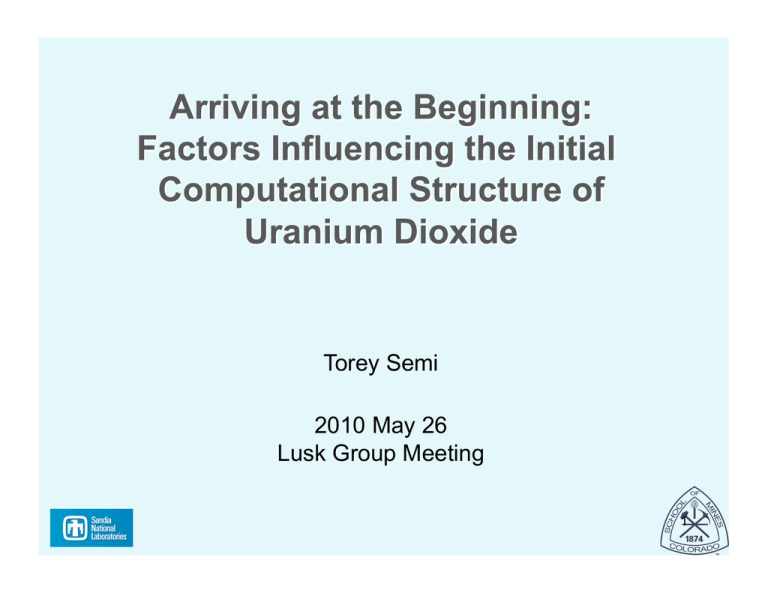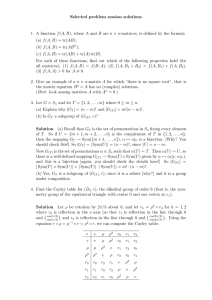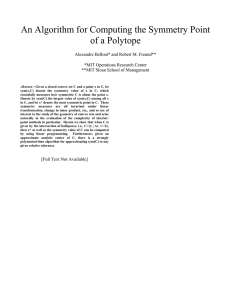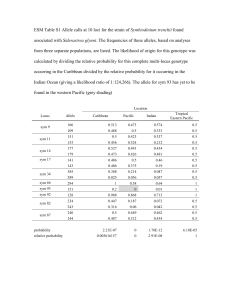Torey Semi 2010 May 26 Lusk Group Meeting 1
advertisement

Torey Semi 2010 May 26 Lusk Group Meeting 1 Fuel Pin Modeling Strategy Multiple Length and Time Scales Continuum Physics Lagrangian-MPM -mechanical stress -lengths: 10-3 - 10-1 m -times: 100 - 109 s MPALE Mesoscale Physics Calibrated Monte-Carlo (CMC) -texture evolution (Potts-Glauber) -pore/bubble transport (Potts-Kawasaki) -lengths: 10-7 - 10-4 m -times: 10-3 - 10-7 s Atomistic Physics Diffusion Theory -energy (conduction) -atomic structure -atomic species -gas clusters -vacancies -lengths: 10-11 - 10-8 m -times: 10-16 - 10-13 s 2 Elucidate the effects of strain on: • Vacancies – single vacancy diffusion – formation/motion of voids • Fission Product Gas Atoms (Kr) – substitutional diffusion (high temperature) – coupled configuration • Kr atom diffusion in the presence of vacancies (midtemperatures) • Schottky defects with Kr atoms – formation/motion of clusters 3 Diffusion Coefficients via DFT D(ε,T) = D0 (T)exp[−E a (ε) /(k B T)] DFT provides: € • activation energy, Ea • vibrational frequencies used to estimate D0 Goals: • study strain effect at atomistic level • inform meso-scale models 4 Analysis of Arrhenius Equation 5 Research Strategies For calculations, use 2x2x2 supercell of UO2: 6 UO2 Magnified 7 UO2 Characteristics • crystallizes at room temperature and ambient pressure in fcc fluorite structure • retains paramagnetic phase up to melting point – Tmelt = 3140K • is an ionically bonded insulator – U4+ (5f2) ions present localized magnetic moments – low temperature magnetic moment: 1.74µΒ/U ion • at TNéel = 30.8K – discontinuous transition from paramagnetic to antiferromagnetic material • magnetic exchange interactions • quadrupole-quadrupole interactions – dynamical 1k J-T distortion to static 3k J-T distortion 8 Considerations for UO2 Electronic Structure Calculations • Relativistic Effects • Functionals • Magnetism • Symmetry 9 DFT: The Actinide Challenge • Relativistic Effects – actinides are heavy elements – incorporation of relativistic effects physically important • Koelling-Harmon approximation • SOC • K-S Exchange-Correlation Functionals – no systematic way to improve – most problematic in materials with: • strongly correlated electrons • localized electrons – UO2 and other actinide oxides meet these criteria 10 The Actinide Challenge • Current Approaches – Pseudopotentials • include relativistic effects using scalar relativistic approximation with spin-orbit coupling as perturbation • PAW method – electron density derived from projector form of all-electron wavefunction Projector functions due to partial waves: 11 The Actinide Challenge • Current Approaches – FP-LMTO • Linear Method (Linearized APW) – K-S equations solved by matching value and energy derivative at MT boundary – non-linear, thus need for linearization • as RSPt, is undergoing implementation of spin-orbit coupling as inherent relativistic effect, with spinpolarization as perturbation – major focus of inter-LDRD effort – implementation of Dirac Equation (DKS): 12 DKS Equation where: 13 The Actinide Challenge • Current Approaches – LDA + U Functional • adds Hubbard term to functional to account for localized electron interactions • parametrized by: – U: reflects strength of on-site Coulomb interaction – J: adjust strength of exchange interaction • simplified form of functional: 14 Research Strategy: Vacancies • First: – Determine efficacy of using GGA vs LDA+U 15 Research Strategy: Vacancies • Then: – Calculate Eact and D for one U vacancy, no strain – Goal: • determine diffusivity of vacancy • decide which functional method is optimal – Method: Transition State Theory • Modify vacancy, perform similar calculations – Oxygen vacancies – Schottky defect 16 Research Strategy: Vacancies Add strain: – account for Soret effect, temperature gradients, other forces – model by lattice dilation • equilibrium LC = 5.550 A • strain by .1%: – stretched LC = 5.555 A – compressed LC = 5.544 A – repeat goals using TST method 17 Research Strategy: Kr Atoms • Introduce into (vacancy) defect – determine energetically preferred defect site Schottky, O vacancies, U vacancy – calculate activation energy to hop to adjacent defect site in unstrained lattice – determine diffusivity • Apply strain – repeat calculations and compare effects to unstrained results 18 Research Strategy: Clusters/Voids • Quantify tendency of motion of N=2, 3, 5, 8 and 10 vacancies, Kr atoms • • • • Agglomeration Energy barriers Temperature dependence Critical size • Calculate diffusivity • Apply strain 19 Calculational Methods • VASP – plane-wave pseudo-potential code • treats core electrons as inert • calculations done on valence electrons only – uses PAW potentials considered best available • RSPt – all-electron code (LAPW) – FP-LMTO – advantage: can massage potentials to work with f-electrons that may penetrate core – disadvantage: settings can be difficult to choose for convergence • Codes are complementary • Exchange-correlation functionals: LDA, GGA 20 VASP method • Establish lattice constant using 7-point method • Perform geometry optimization on 2x2x2 UO2 supercell • Create endpoint and intermediate images for TST calculations on U vacancy • Perform NEB calculations to determine activation energy for U vacancy 21 Lattice Constant Determination Estimated values: LDA+U: 5.550 Å GGA: 5.424 Å 22 Lattice Constant Comparison Relative to LDA+U value: Method: VASP Lattice Constant, Å PAW-SP-GGA+U 5.520 .0054 5.490 .0108 5.470 .0144 (Gupta)4 PAW-SP-GGA+U (Nerikar)4 Experiment (Villars, Baer)4 5.550 Å 23 Comparison of UO2 Bulk Properties Author Method LC (Å) Bulk Mod (GPa) Coh En (eV/UO2) Mag Mom Band Gap (µΒ) (eV) Var. Ref. Expt 5.47 207 22.31 1.74 2.1 Gupta GGA 5.38 209 23.58 none none this work GGA 5.42 205 23.09 none none Nerikar GGA+U (D) 5.49 - - 1.93 1.9 Gupta GGA+U (D) 5.52 209 21.71 1.94 1.8 Yun GGA+U (D) 5.44 209 20.26 1.89 1.8 Dorado GGA+U (D) 5.52 214 21.30 2.00 2.1 this work GGA+U (D) 5.55 191 21.54 2.00 2.2 this work GGA+U (L) 5.55 191 21.82 2.00 2.4 24 Magnetism • Jahn-Teller Theorem – Any non-linear molecular system in an orbitally degenerate electronic state will be unstable with respect to a distortion, and will form a system of lower energy, lifting the degeneracy. – Consequences for UO2: • • • • z-axis compression point group from Oh to Dh4 lowers ground state by ~ 50 meV distortion of O cage by 0.086 Å 25 Magnetism • Occupation Matrices – describe: • magnetic states of 2 U f-electrons • orbital occupancies of 2 U f-electrons – point group symmetry: • completely determines form • UO2: – from Oh to Dh4 at Neel temperature – consistent with z-axis compression 26 Magnetism • Occupation Matrices – 7x7 (l=3) – basis: real spherical harmonics – matrix entries: • diagonal = eigenvectors • non-diagonal = linear combinations of eigenvectors • sign determines direction of spin – issue: • LDA + U – Dudarev Method – Lichtenstein Method 27 UO2 G.S. Occupation Matrix ⎛ a ⎜ ⎜ 0 ⎜ b ⎜ ⎜ 0 ⎜ 0 ⎜ ⎜⎜ 0 ⎝ 0 0 b 0 0 0 0 0 1− a 0 0 0 0 0 0 0 0 0 0 0 0 0 0 0 0 0 1− a 0 0 0 0 0 0 0 −b 0 0 ⎞ ⎟ 0 ⎟ 0 ⎟ ⎟ 0 ⎟ −b⎟ ⎟ 0 ⎟ ⎟ a ⎠ ⎛ .3 ⎜ ⎜ 0 ⎜.4 ⎜ ⎜ 0 ⎜ 0 ⎜ ⎜⎜ 0 ⎝ 0 0 .4 0 .1 0 0 0 .7 0 0 0 0 0 0 0 0 0 0 0 0 0 0 .7 0 0 0 0 0 0 0 0 0 0 −.4 0 0 ≤ a ≤1 -1 ≤ b ≤ 1 b≠0 € ⎞ ⎟ ⎟ ⎟ ⎟ 0 ⎟ −.4 ⎟ ⎟ 0 ⎟ ⎟ .3 ⎠ 0 0 0 28 Magnetism • UO2 transitions from dynamical 1k to static 3k – at Neel temperature (30.8K) – dynamical nk • vibronic states tunnel between energetically equivalent positions in distorted geometry – static nk • nuclear states confined to single well – above Néel temperature • dynamical 1k averages to crystal flourite structure – below Néel temperature • static 3k exhibits geometric (Jahn-Teller) distortion 29 Magnetism • Magnetically ordered nk crystal system: – involves expansion of the moment distribution in a Fourier series of ‘star of k’ – UO2 ground state: • magnetic order 3k • we use 1k to approximate – for U < 4.76 eV, 3k unstable (Lichtenstein) – U = 4.5 eV (Kotani) – 3k and 1k energies very close » issue of computational efficiency 30 1x1x1 UO2 Calculations: From Fm3m Starting Structure Sym Relax O Cage Atom Displ Start Shape End Shape Occ Mat G.S. En (eV) off all no not sgnf cubic tetra g.s. -118.42 on all no no cubic tetra g.s. -118.42 off ions no no cubic cubic g.s. -118.40 on ions no no cubic cubic g.s. -118.40 31 Effects of Translational O Atom Displacement O Atom Displ (Å) Sym Relax O Cage U Dspl Start End Occ Mat G.S. En (eV) .01 off all sym sym cubic sl. tetra g.s. off -115.71 .01 off ions sym sym tetra tetra g.s. -118.41 .01 off ions sym sym cubic cubic g.s. -118.40 .02 off all sym sym cubic sl. tetra .02 off ions sym sym tetra tetra .02 off ions sym sym cubic cubic metast. -118.02 .1 off ions yes yes tetra tetra NOT g.s -116.19 .1 off ions yes yes cubic cubic g.s. off -118.10 metast. -118.02 g.s. -118.41 Illustrates that: – Fm3m 1k gives ground state – symmetric and asymmetric starts do not give significantly different results 32 – metastable states sometimes reached Effects of ‘Random’ O Atom Displacement O Atom Displ (Å) Sym Relax O Cage U Displ Start End Occ Mat G.S. En (eV) .01 on all sym sym cubic slightly tetra g.s. #s off -118.48 .01 off all sym sym tetra tetra g.s. -118.48 33 Initial Structure • subsequent calculations based on: – ground state structure calculation • ions initially positioned symmetrically • symmetry ‘turned on’ • full relaxation allowed • 1k magnetic ordering – emergent structure • tetrahedral (J-T distortion) • symmetric ion positioning – computational efficiency 34 3-Image NEB UO2 Vacancy Calculation Eact = 4.43 eV DFT Trends: Uranium Vacancies Author Year Experiment or DFT Prediction Activation Energy (eV) Calculated Diffusion Coefficient m2/sec Matzke 19926 Expt 2.40 ~1.4x10-20 3.09 ~10-24 4.43 ~10-30 Yun 20087 Yun 2008 model: w/sp po model: non-magn Durinck 20078 model 4.40 ~10-30 Grimes 19919 model 2.10 ~10-19 Semi Calc model: LDA+U 4.43 ~10-30 5-Image NEB Cu Vacancy Calculation Eact = 0.74 eV 37 Actual Result: Cu Vacancy Author Year Experiment or DFT Prediction Activation Energy (eV) Calculated Diffusion Coefficient m2/sec Soisson 200710 Expt 0.7 ± .02 ~5.7x10-13 Soisson 200710 model: SIESTA 0.64 ~1.1x10-12 Semi calculation model: VASP 0.74 ~3.7x10-13 Current Calculations TST (NEB) calculations – 2x2x2 UO2 supercells • 1 using GGA only • 1 using LDA+U – 3 and 5 intermediate images – NSW set as projected maximum – run until change in activation energy is less than .05 eV with respect to the number of iterations – determine whether to use GGA or GGA+U – continue on ‘Research Strategy’ path 39 References 40 References 41 Dirac Equation: Connection to RDFT Scalar Relativistic Approximation – an approximation to the Dirac equation for a particle in a (central) potential (such as an electron near a nucleus) – applicable to calculation of relativistic effects in atoms and molecules – approach is to treat spin-orbit term as perturbation • spin-orbit term is of negligible size • address perturbation in core (spherically) 42 Pre-exponential Factor We use: confirmed in VASP: 10.76 THz < Uvib freq < 17.64 THz 43 Pre-exponential Factor: Independent of T Case 1: T > 1675 K 44 DFT: The Actinide Challenge • Current Approaches – LDA + U Functional • adds Hubbard term to functional to account for localized electron interactions – Pseudopotentials • include relativistic effects using scalar relativistic approximation with spin-orbit coupling as perturbation – FP-LMTO • as RSPt, is undergoing implementation of spin-orbit coupling as inherent relativistic effect, with spin-polarization as perturbation – major focus of inter-LDRD effort 45 Pre-exponential Factor: Temperature Dependence Case 2: 1075 K < T < 1675 K: where # of vacancies in the neighborhood of the Kr atom is an Arrhenius function of T 46 UO2 2x2x2 NEB Endpoints 47





